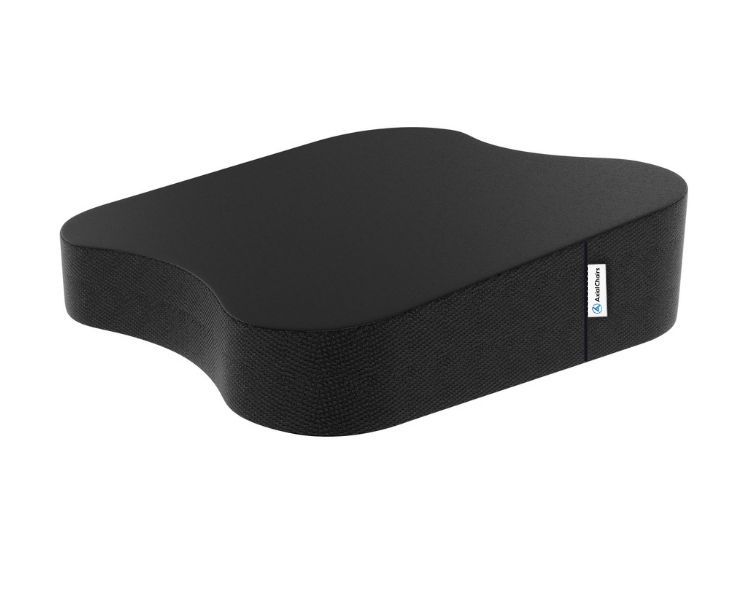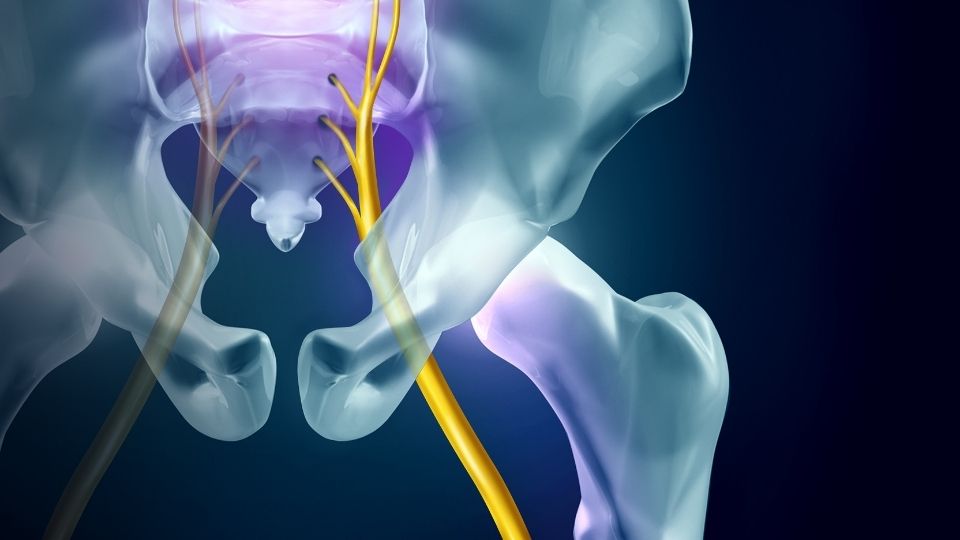Do you find yourself suffering with sciatica pain when you sit down? You’re not alone. Sciatica is a common complaint, affecting many of us at some point during our lives. If your job or lifestyle requires long periods of sitting, it can be even more vexing to experience such discomfort while sitting! Fortunately, there are plenty of ways to help alleviate the pain and reduce your symptoms associated with this condition. In this blog post, we’ll explore what can cause sciatic nerve pain when sitting and provide tips for how you can relieve its unpleasant effects. Read on for everything you need to know about why your sciatic nerves hurt when seated – as well as solutions designed to ease the ache!
As a general rule, sciatica pain during sitting is caused by pressure on the sciatic nerve from herniated disc, spinal stenosis, or piriformis syndrome. Prolonged sitting worsens pain by compressing the nerve. Alleviate discomfort with proper posture, ergonomic seat cushion, breaks, and stretching exercises.
Let me guide you through the best way to sit with sciatica. For over 30 years, I’ve been practicing chiropractic, and during that time, I’ve also trained as an ergonomist. I have a published book on posture, spoke on this subject on national tv, and have engineered several solutions to help people achieve better posture and comfort while sitting. In addition, I ran a successful Kickstarter campaign to fund the development of a set of ergonomic seat cushions. With all this experience and expertise, I’m confident I can offer some excellent advice that can help reduce or even eliminate discomfort.
Causes of Sciatica Pain When You Sit or When Standing
Several factors may contribute to sciatica pain when sitting. These include:
- Lumbar Disc Herniation: A herniated disc occurs when the soft, gel-like center of an intervertebral disc protrudes through the tougher outer layer, compressing the nearby sciatic nerve and causing inflammation.
- Lumbar Spinal Stenosis: Spinal stenosis is the narrowing of the spinal canal or the spaces between the vertebrae, which can compress the spinal cord and nerves, including the sciatic nerve.
- Piriformis Syndrome: The piriformis muscle, located in the buttocks, can become tight or spasm, compressing the sciatic nerve and causing pain.
- Sacroiliac Joint Dysfunction: The sacroiliac joint connects the spine to the pelvis. Inflammation or dysfunction of this joint can irritate the sciatic nerve.
- Poor Posture: Sitting for prolonged periods with poor posture can cause muscle imbalances, which can lead to sciatica pain.
Symptoms of Sciatica | Sciatic Pain | Sciatica Worse
The primary symptom of sciatica is pain that radiates from the lower back down through the buttocks and legs, usually affecting one side of the body. Other common symptoms include:
- Numbness or tingling in the affected leg
- Weakness or difficulty moving the leg or foot
- A sharp, burning, or shooting pain that may worsen when sitting
- A dull, aching pain in the lower back, hip, or buttocks
Preventing and Managing Sciatica Pain When Sitting
To prevent and manage sciatica pain while sitting, try the following strategies:
1. Maintain Proper Posture: Sit with your back straight, shoulders relaxed, and feet flat on the floor. Use a lumbar roll or cushion to support the natural curve of your lower back.
2. Take Regular Breaks: Stand up and stretch every 20 to 30 minutes to alleviate pressure on the sciatic nerve.
3. Adjust Your Workstation: Ensure that your chair, desk, and computer screen are at the correct height to promote good posture.
4. Use a Seat Cushion: A cushion specifically designed for sciatica pain relief can help distribute weight evenly and reduce pressure on the sciatic nerve.
5. Strengthen Your Core Muscles:
Engaging in core-strengthening exercises can help support your spine and reduce the risk of developing sciatica.
6. Stretch Regularly: Incorporate stretches targeting the lower back, hips, and legs into your daily routine to improve flexibility and alleviate sciatica pain.
7. Maintain a Healthy Weight: Excess body weight can put additional pressure on your spine and sciatic nerve. Maintaining a healthy weight can help reduce the risk of sciatica.
All Day Comfort & Support
Seeking Professional Help for Sciatica | Lower Back
If your sciatica pain persists or worsens, it is essential to consult a healthcare professional for a proper diagnosis and treatment plan. Depending on the underlying cause, your healthcare provider may recommend one or more of the following treatment options:
Physical Therapy: A physical therapist can design a tailored exercise and stretching program to alleviate your sciatica pain and prevent future occurrences.
Medication: Over-the-counter pain relievers, anti-inflammatory drugs, or muscle relaxants may be prescribed to manage your pain and inflammation.
Epidural Steroid Injections: These injections deliver corticosteroids directly into the epidural space surrounding the spinal cord, reducing inflammation and providing pain relief.
Chiropractic Care: Chiropractic adjustments can help realign the spine, alleviate pressure on the sciatic nerve, and provide pain relief.
Acupuncture: Acupuncture is a traditional Chinese medicine technique that involves inserting thin needles into specific points on the body to alleviate pain and restore balance.
Massage Therapy: Massage can help relax tight muscles, improve circulation, and relieve pressure on the sciatic nerve.
Surgery: In severe cases or when conservative treatments fail, surgery may be necessary to remove the source of nerve compression, such as a herniated disc or bone spur.
Last Stages of Sciatica: Recognizing Warning Signs and Seeking Relief
In the last stages of sciatica, unexplained pain and discomfort may become more intense. If you’re experiencing these symptoms, it’s important to be aware of the potential warning signs of developing prostate problems as well. Men’s health is essential, and prostatitis can sometimes contribute to sciatica-like symptoms. Enlarged prostate or enlargement of the prostate can cause urinary tract issues, which in turn may exacerbate sciatica pain.
Say Goodbye to Sciatic Nerve Pain in Just 10 Minutes With This Natural Method
Sciatic nerve pain, or sciatica, can be debilitating and uncomfortable, but with this 10-minute natural method, you can experience relief without relying on medication. This method focuses on gentle stretches and exercises to alleviate pressure on the sciatic nerve, promote blood circulation, and reduce inflammation. Please consult your healthcare professional before attempting any new exercise routines, especially if you have a history of back pain or other medical conditions.
Knees-to-Chest Stretch:
Lie on your back with your legs extended.
Gently bring one knee towards your chest, clasping your hands around your shin or thigh.
Hold for 20-30 seconds, then switch legs.
Repeat 3 times on each leg.
Piriformis Stretch:
Lie on your back with both knees bent and feet flat on the floor.
Place your right ankle over your left knee.
Gently pull your left thigh towards your chest, holding your hands behind your left thigh or shin.
Hold for 20-30 seconds, then switch legs.
Repeat 3 times on each leg.
Seated Spinal Twist:
Sit on the floor with your legs extended in front of you.
Bend your right knee and place your right foot on the outside of your left knee.
Twist your upper body gently to the right, placing your right hand on the floor behind you for support.
Hold for 20-30 seconds, then switch sides.
Repeat 3 times on each side.
Cat-Cow Stretch:
Begin on your hands and knees, with your hands directly under your shoulders and your knees under your hips.
Inhale and arch your back, dropping your stomach towards the floor and lifting your head and chest (Cow pose).
Exhale and round your back, tucking your chin into your chest and drawing your navel towards your spine (Cat pose).
Repeat this flow for 1 minute.
Child’s Pose:
From the Cat-Cow position, sit back on your heels with your big toes touching and your knees slightly wider than hip-width apart.
Extend your arms forward, resting your forehead on the floor.
Hold this pose for 1 minute, focusing on deep breathing.
Performing these stretches and exercises daily can help relieve sciatic nerve pain and increase flexibility. It’s essential to listen to your body and stop if any movement causes discomfort. Consult a healthcare professional for personalized advice and remember that consistency is key for long-term results.
Best Seat Cushion for Sciatic ReliefAxial Ergonomic Seat Cushion® | Seat Chair Wedge
Quick Guide: A 30-Second Summary

All Day Comfort & Support
Product Name
Axial Designs™ Seat Cushion
Price
$149
Warranty
1 Year
Type
Posture Wedge
Top Layer
100% Natural Latex (Molded)
Bottom Layer
High-Density Foam
Top Material
Isometric Grippy Vegan Leather
Bottom Material
Non-Slip Material
Side Material
3D Breathable Fabric
How to Prevent Sciatica Pain When Sitting | Sciatica Worse
Sitting for extended periods can exacerbate sciatica pain. However, if you are also experiencing unexplained pain, it’s important to be aware of warning signs for men’s health issues, such as prostatitis or an enlarged prostate. In some cases, an enlarged prostate can cause urinary tract issues or even be a symptom of prostate cancer. To prevent sciatica pain when sitting and also be mindful of your prostate health, consider the following tips.
- Maintain proper posture: Sitting with poor posture can worsen sciatica pain, but if you maintain proper posture, it can help alleviate discomfort. Make sure your feet are flat on the floor, and your back is supported.
- Take breaks: Sitting for long periods can aggravate sciatica pain and contribute to prostate problems. Taking breaks to stand up and stretch every 30 minutes to an hour can be beneficial for both your sciatic nerve and prostate health.
- Use a cushion or pillow: If you sit for long periods, using a cushion or pillow to support your lower back can help reduce sciatica pain. This may also help alleviate pressure on your prostate if it is enlarged or swollen.
- Manage your weight: Carrying excess weight, particularly around your belly, can increase pressure on your sciatic nerve and be a red flag for prostate health. Maintaining a healthy weight can help prevent sciatica pain and reduce the risk of developing prostate issues, such as an enlarged prostate or prostate cancer.
- Be mindful of your prostate health: Regular check-ups with your doctor can help identify prostate issues, such as prostatitis, enlargement, or cancer. Early detection is key to successful treatment and can help prevent complications, such as urinary tract infections.
Immediate Relief for Sciatica Pain | Healthcare Provider
Sciatica pain can be severe and may require medical treatment. Here are some immediate relief strategies that healthcare providers may suggest:
- Ice or Heat Therapy: Applying ice or heat to the affected area can help reduce inflammation and relieve pain. Place an ice pack or a heating pad on the affected area for 15 to 20 minutes at a time.
- Medication: Over-the-counter pain relievers such as ibuprofen or naproxen may help reduce pain and inflammation. In some cases, prescription medication may be necessary.
- Stretching: Gentle stretching exercises can help relieve pressure on the sciatic nerve. Healthcare providers may recommend specific stretches that are safe and effective.
- Massage: Massaging the affected area may help relieve tension and reduce pain. A licensed massage therapist or physical therapist may be able to provide relief.
- Rest: It is important to rest and avoid activities that may exacerbate the pain. However, prolonged bed rest is not recommended and may actually delay recovery.
- Physical therapy: A healthcare provider may recommend physical therapy to help stretch and strengthen the muscles that support the lower back and reduce pressure on the sciatic nerve.
It is important to consult with a healthcare provider if you are experiencing sciatica pain. They can help diagnose the underlying cause of the pain and recommend appropriate treatment strategies.
Signs of Sciatica Improving
The Importance of Monitoring Prostate Health As your sciatica pain begins to improve, it is crucial to continue monitoring your prostate health. If you can recognize the connection between a swollen prostate and sciatica, you’ll be better equipped to maintain lasting relief. Keep an eye on symptoms such as pain in the lower back or belly—it can also raise the red flag for your prostate health.
All Day Comfort & Support
Conclusion
Sitting certainly has its risks as many of us can suffer from sciatica pain while taking a seat. Understanding why it’s happening is the best way to find relief and prevent further damage. Because it could take weeks, months or even years before we know what the underlying cause may be, it is important to keep track of our symptoms. You should talk to a doctor if the pain gets worse over time or if any accompanying symptoms arise. Rest, gentle physical activity and possibly medicines are some of the most common ways to address sciatica flare-ups. Lastly, finding an ergonomic chair that is designed for comfort and good back support can also be helpful in reducing sciatic pain from sitting. By staying informed and proactive with our health, we can keep track of any sudden changes in our bodies and minimize the risk of aggravating existing issues like sciatica pain!






